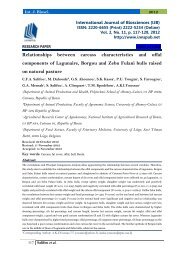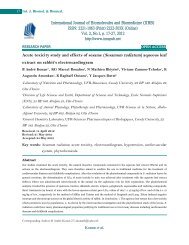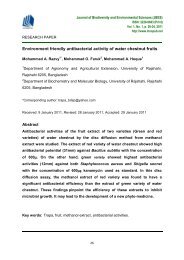Full Text - International Network for Natural Sciences | INNSPUB
Full Text - International Network for Natural Sciences | INNSPUB
Full Text - International Network for Natural Sciences | INNSPUB
Create successful ePaper yourself
Turn your PDF publications into a flip-book with our unique Google optimized e-Paper software.
Int. J. Biosci. 2013<br />
been reported in freshwater crustacea, water fleas,<br />
scud, mosquito, midge, shell (snail) and oligochaete.<br />
Results showed that the 48hr EC50 values of<br />
immobilization in water flea were 0.000144 and<br />
0.000266mg/L (Brooke, 1991; MOE/Japan, 2002),<br />
the 96hr LC50 in minaminuma shrimp was<br />
0.00719mg/L (MOE/Japan, 2002) and 96hr LC50 in<br />
one of freshwater pulmonate (Physella virgata) was<br />
0.17mg/L (Brooke, 1991). In addition, the LC50<br />
values ranged from 0.0158 to 0.0176mg/L in insects<br />
and 0.0075 to 0.31mg/L in shell (snail), which<br />
indicates strong effects of dichlorvos on these<br />
organisms similar to those on crustacean (CERI,<br />
2007) and the result obtained in this study.<br />
may result in different patterns of biotrans<strong>for</strong>mation,<br />
leading to more or less toxic metabolites (Johnson<br />
and Toledo, 1993). The magnitude of toxic effects of<br />
pesticide also depends on length and weight,<br />
corporal surface/body weight ratio and breathing<br />
rate (Murty, 1986). Metabolic differences between<br />
different animal classes may also be responsible <strong>for</strong><br />
differential toxicity of chemicals.<br />
The number of survivors of Pila ovata exposed to<br />
different concentrations of dichlorvos differ<br />
significantly (p








